|
|
3rd Signal Co. Photography WWII :: U.S. 3rd Infantry Division
»» SMALL SCREEN »» DESKTOP SITE
d o g f a c e s o l d i e r
U. S. 3 r d I n f a n t r y D i v i s i o n
WWII images from five combat
photographers of the U.S. 3rd Infantry Division
_______________________________________
surf all sections : ANZIO | ROME | DRAGOON
BREAKOUT | MONTELIMAR | VOSGE | STRASBOURG
COLMAR POCKET | RHINELAND | GERMANY | AUSTRIA
_______________________________________

|
|
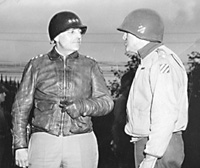
< Lt. Gen. Truscott – VI CORPS and Maj. Gen. O'Daniel – 3rd Division Grandvillers, France – Oct. 29, 1944
THE U.S. 3RD DIVISION earned its motto "Rock of the Marne" during the German offensive of 1918. The division formed in 1917 at Camp Greene, near Charlotte in North Carolina and quickly found itself in the great Battle of the Marne that turned the tide against the Germans in WWI. During six months of combat in the war, the 3rd Division suffered 16,856 casualties during six campaigns.
During WWII, the "Marne Men" served in Africa, Sicily, Italy, France, Germany, and Austria. To the German army they were known as the Blue and White Devils and the Sturm Division for their aggressive action in Italy.
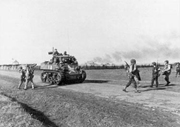
< 7th Infantry Regiment near Fedala, Morocco during Operation Torch – Nov. 1942
As one of the first five U.S. divisions to enter the European war in November 1942, the 3rd Division was active for 30 months — logging 553 days in combat. The division assaulted four beachheads, suffered 25,977 battle casualties and honored 39 of its own with the Medal of Honor. Its soldiers earned over 4,800 Silver Stars and 14 Distinguished Unit Citations. The entire division wears the fourragere of the French Croix de Guerre for its action in the Battle of the Colmar Pocket.
Suffering the most casualties of the 89 major American units serving in WWII, the 3rd Division is the only American division to battle Axis forces on all European fronts: French Morocco, Tunisia, Sicily, Naples-Foggia, Rome-Arno, Southern France, Rhineland, and Central Europe.
Of its men, Audie Murphy is known as the most decorated combat soldier in American history. Maurice Britt was the first U.S. soldier to earn the three highest military decorations in a single war. During the breakout from Anzio on May 23, 1944 the 3rd Division suffered 995 men killed or wounded, the most casualties suffered by a single division in a single day. In the final months of 1944, the 3rd Division was a part of the first army to cross the Vosges Mountains against an enemy.
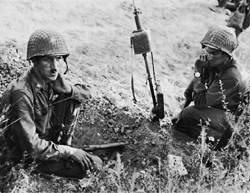
< 30th Rgt. C.O. Lt. Col. Lyle Bernard during Operation Husky - near Brolo – Aug. 1943
The 3rd Division fought over a trail of 3,200 miles in seven countries and ten campaigns beginning with Operation Torch in November 1942 landing near Fedala in Morocco. The division served as part of the Western Task Force assault on Casablanca commanded by General George Patton who later led the Seventh Army in Sicily in 1943.
During Operation Husky, the 3rd Division landed in Sicily near Licata on July 10, 1943. After fighting toward Palermo, Gen. Patton ordered the advance to halt so he and his tanks could enter as victors even though elements of the 7th Regiment were already in the city. Next, the division — at great cost — fueled Patton's race to Messina to best British Field Marshal Montgomery and his Eighth Army that fought bitterly up Sicily's eastern coast. The 7th Regiment secured Messina and 3rd Division Commander, General Truscott accompanied General Patton into the city on Aug. 17, 1943, marking 38 days for the Allies to secure Sicily.
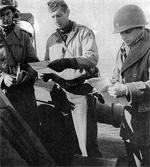
< Lt. Gen. Mark Clark offshore at Anzio during Operation Shingle – Jan. 22, 1944
IN SOUTHERN ITALY, the division passed through the Salerno beachhead to assault Ascerno and then north beyond Naples to spearhead the October 1943 crossing of the Volturno River allowing Fifth Army troops to drive to Cassino. At the end of 1943, the 3rd Division was pulled from the front line to train for Operation Shingle, the behind-the-lines landing at Nettuno and Anzio meant to break the stalemate at Cassino that turned into a vicious four-month battle. As part of the main beachhead force landing at Anzio in January 1944, the 3rd Division went on to battle three German divisions during the February counterattack and spearhead the final breakout four months later. From the Anzio beachhead the division saw action at Cisterna, Cori, Guiglianello, Artena and Valmontone before reaching Rome on June 4, 1944.
The 3rd Division history describes the fighting in Italy as " ... the bitterest, most heartbreaking, most cursed battlefield of the longest-fought campaign in Europe."
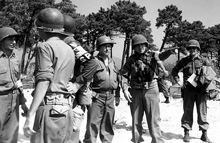
< Maj. Gen. O'Daniel at Cavalaire during Operation Dragoon – Aug. 15, 1944
AFTER ITS FOURTH AMPHIBIOUS ASSAULT of the war on southern France, the 3rd Division battled through the Vosges Mountains to the Rhine River and was instrumental in reducing the Colmar Pocket in early 1945. After its assault into Germany on the Siegfried line near Zweibrucken in March 1945, the division crossed the Rhine River near Worms and battled through Nuremberg and Munich, ending its march against the German 19th Army in Austria in May 1945 as the first Allied troops to reach Hitler's Berghof.
The 3rd Division's regiments date to the War of 1812 with the 15th Regiment – the "Can Do" regiment – notable for six Civil War battles and a 26-year assignment in China ending in 1938. The 7th Regiment is known as the "Cottonbalers" for their engagement in the battle of New Orleans in the War of 1812. Both the 7th and the 30th – stationed at San Francisco's Presidio from 1923-1941 – were part of the 3rd Division in WWI.
"Dogface Soldier", written in 1942, is the theme song of the 3rd Division.
^ Back to Top
surf all sections : ANZIO | ROME | DRAGOON
BREAKOUT | MONTELIMAR | VOSGE | STRASBOURG
COLMAR POCKET | RHINELAND | GERMANY | AUSTRIA
3rd Sig. Photographers :: HOME PAGE :: Dogface Gallery
navigation-->
Copyright © 2005-2023 Tansi Publishing. All rights reserved.
|
 |
 |
|
|

